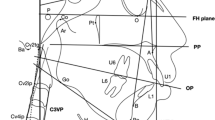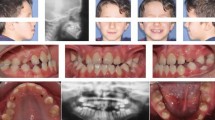Abstract.
Background and Aim:
The assessment of correlations between orthopedic and orthodontic data based on interdisciplinary studies is of scientific and practical interest in the differentiation of preventive diagnostic and therapeutic fields between orthodontics and orthopedics. In the published literature there are various studies analyzing the correlations between specific Angle classes and orthopedic parameters. Results of these studies indicate a potential correlation between scoliosis and Class II malocclusion as well as between weak body posture and Class II malocclusion. The aim of the present interdisciplinary study was to examine correlations between orthodontic and orthopedic findings in preschool infants and to evaluate them with respect to preventive recommendations.
Patients and Method:
59 pre-school infants (29 boys, 30 girls) aged 3.5–6.8 years (mean: 5.0 years) were enrolled in this study. A standardized orthodontic and orthopedic examination protocol was used.
Results:
The orthodontic examination showed Angle class distributions comparable with those in non-selected groups (Class I: 63%, Class II: 32%, Class III: 5%). The orthopedic examination revealed pathologic findings in 52% of the subjects, with statistically significant correlations between scoliosis and Class II malocclusion (p = 0.033) and between weak body posture and Class II malocclusion (p = 0.028).
Conclusion:
It can be concluded from the results that the orthodontic finding of Angle Class II in pre-school infants should induce prophylactic screening. The orthodontist could then not only initiate early orthodontic treatment to prevent incisor trauma in patients with extreme overjet, but could also take account of potential orthopedic malformations on a preventive interdisciplinary basis in pre-school infants with Class II malocclusions.
Zusammenfassung.
Hintergrund und Ziel:
Die Bewertung von Beziehungen zwischen orthopädischen und kieferorthopädischen Befunden auf der Basis von interdisziplinären Studien ist von wissenschaftlichem und praktischem Interesse für die Differenzierung von präventiven gemeinsamen Diagnostik- und Therapiebereichen zwischen Kieferorthopädie und Orthopädie. Im bekannten Schrifttum finden sich mehrere Studien, welche Zusammenhänge zwischen bestimmten Angle-Klassen und orthopädischen Parametern evaluieren. Ergebnisse dieser Studien deuten auf eine mögliche Beziehung von Skoliosen und hypotoner Körperhaltung mit Angle-Klasse-II-Dysgnathien hin. Prospektives Ziel der vorliegenden interdisziplinären Studie war es, Beziehungen zwischen orthopädischen und kieferorthopädischen Befunden bei Vorschulkindern zu untersuchen und hinsichtlich präventiver Empfehlungen zu evaluieren.
Patienten und Methode:
59 Vorschulkinder im Alter von 3,5 bis 6,8 Jahren wurden in diese Studie einbezogen. 29 Patienten waren männlich, 30 weiblich. Es erfolgten eine standardisierte klinische kieferorthopädische und orthopädische Untersuchung.
Ergebnisse:
Bei der kieferorthopädischen Untersuchung zeigte sich eine der Verteilung in unselektierten Gruppen entsprechende Angle-Klasse-Häufigkeit (Angle-Klasse I 63%, Angle-Klasse II 32% und Angle-Klasse III 5%). Die orthopädische Untersuchung ergab bei 52% der Probanden Auffälligkeiten mit den folgenden statistisch signifikanten Korrelationen: Angle-Klasse II und Skoliose (p = 0,033) sowie Angle-Klasse II und hypotone Körperhaltung (p = 0,028).
Schlussfolgerung:
Aus den Ergebnissen kann geschlussfolgert werden, dass bei Kindergartenkindern der kieferorthopädische Befund der Angle-Klasse II eine mögliche prophylaktische Screeninguntersuchung auslösen sollte. Der Kieferorthopäde kann somit nicht nur bei extremer Frontzahnstufe eine kieferorthopädische Frühbehandlung zur Frontzahntraumaprophylaxe initiieren, sondern auch bei Angle-Klasse-II-Dysgnathien aller Schweregraduierungen interdisziplinär präventiv mögliche orthopädische Fehlentwicklungen berücksichtigen.
Similar content being viewed by others
Author information
Authors and Affiliations
Corresponding author
Rights and permissions
About this article
Cite this article
Lippold, C., van den Bos, L., Hohoff, A. et al. Interdisciplinary Study of Orthopedic and Orthodontic Findings in Pre-school Infants. J Orofac Orthop 64, 330–340 (2003). https://doi.org/10.1007/s00056-003-0236-4
Received:
Accepted:
Issue Date:
DOI: https://doi.org/10.1007/s00056-003-0236-4
Key Words:
- Class II malocclusion and scoliosis
- Class II malocclusion and weak body posture
- Early orthodontic treatment and orthopedics




